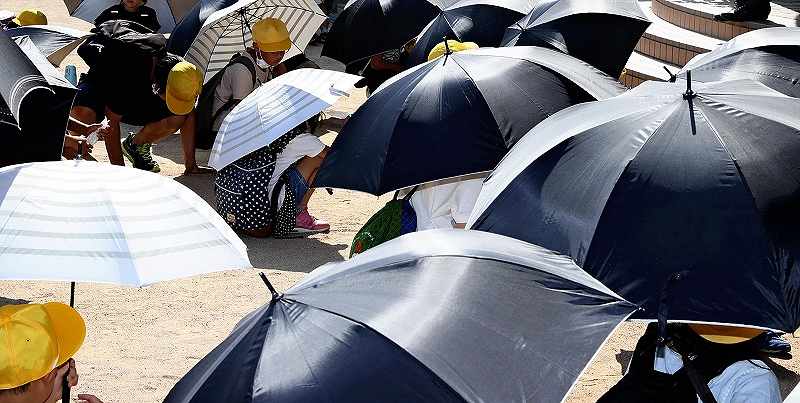
Students under parasols gather in the schoolyard before leaving for home in groups in Tamba, Hyogo Prefecture, in early July.
12:24 JST, July 16, 2022
OSAKA — Under a clear blue sky on an afternoon in early July, students at a Hyogo Prefecture elementary school began their walk home in groups. What made this scene different than usual was that the students all had parasols.
As the summer gets into full swing, concern is rising with the temperature on how schools can prevent heatstroke among students, particularly during their commute to and from school when they are out of sight of adults.
In addition to having students take off their masks, schools are taking such measures as lending out parasols to keep them out of direct sunlight, or having the students leave heavy textbooks at school to lighten their bags.
With temperatures set to soar across the country throughout the summer, experts are urging children to stay hydrated.
The mercury hit 32.9 C in Tamba, Hyogo Prefecture, on July 7, when students at Maeyama Elementary School made their walk home under parasols.
That day’s Wet Bulb Globe Temperature (WBGT) — which measures the risk of heatstroke based on temperature, humidity and the intensity of the sun — was at the “severe warning” level, the second-highest on the scale. At that level, heavy physical activity is restricted.
In 2020, the school closed at one time due to the coronavirus pandemic, forcing it to shorten its summer recess. It bought parasols at that time to prevent heatstroke and began lending them to all 75 students for their commutes to and from home.
Opening the parasols also helps students to maintain a distance of one to two meters between each other, so the school directs them to take off their masks. It also distributes salt tablets to help replenish sodium in their bodies.
“It’s cooler because putting up the parasol creates shade,” a first-grader said with a smile.
His walk takes 20 to 30 minutes, and the student’s mother said, “As they have to walk under the hot sun, it’s a bit reassuring that they have parasols.”
Lightening the load
For the week of June 27-July 3, when temperatures reached 35 C and above across the country, 14,353 people were transported by ambulance due to heatstroke nationwide, according to the Fire and Disaster Management Agency.
That figure was more than 10 times higher than in the same period last year, and includes 1,248 children between 7 and 17.
As children are not as tall as adults, they are more likely to be strongly exposed to sunlight reflected off the ground and therefore feel hotter.
The Education, Culture, Sports, Science and Technology Ministry has repeatedly called on school boards nationwide to ensure that students are instructed to remove their masks when they walk to and from school and during physical education classes.
In June, the Hirakata No. 2 Elementary School in Hirakata, Osaka Prefecture, initiated a program in which students ditched their bulky randoseru backpacks for lighter handbags and left textbooks in the classrooms.
The randoseru tends to trap heat between the student’s back and the backpack.
The school board in Motosu, Gifu Prefecture, has urged its municipal elementary schools to take similar measures.
The Kobe board of education is urging students at junior high schools that have uniforms to wear their PE class uniforms or other light clothes to and from school instead.
In-school vending machines
The city-run Sakae Junior High School in Toyoake, Aichi Prefecture, installed a vending machine in the building to encourage students to keep hydrated.
In a rare move for a public school, the student council took the initiative in establishing rules such as “You can only bring ¥300 with you,” and “Lending, borrowing or treating others is prohibited.”
In Osaka’s Higashi-Yodogawa Ward, the city-run Komatsu Elementary School set up equipment to measure the WBGT. On days when the index reaches a dangerous level, all physical activity, including swimming, is prohibited.
At Sumire Junior High School in Osaka’s Joto Ward, three tents were set up on the schoolyard to use for shade during breaks in after-school sports.
“We urge schools to use their ingenuity and come up with measures, no matter how small,” an Osaka school board official said.
"Society" POPULAR ARTICLE
-

M4.9 Earthquake Hits Tokyo, Neighboring Prefectures
-

Israeli Tourists Refused Accommodation at Hotel in Japan’s Nagano Pref., Prompting Protest by Israeli Embassy and Probe by Prefecture
-

M7.5 Earthquake Hits Northern Japan; Tsunami Waves Observed in Hokkaido, Aomori and Iwate Prefectures
-

Tsukiji Market Urges Tourists to Avoid Visiting in Year-End
-

High School in Kyoto Says Students Shoplifted during Recent School Trip to Bali, Indonesia
JN ACCESS RANKING
-

Tokyo Economic Security Forum to Hold Inaugural Meeting Amid Tense Global Environment
-

Keidanren Chairman Yoshinobu Tsutsui Visits Kashiwazaki-Kariwa Nuclear Power Plant; Inspects New Emergency Safety System
-

Imports of Rare Earths from China Facing Delays, May Be Caused by Deterioration of Japan-China Relations
-

University of Tokyo Professor Discusses Japanese Economic Security in Interview Ahead of Forum
-

Japan Pulls out of Vietnam Nuclear Project, Complicating Hanoi’s Power Plans























